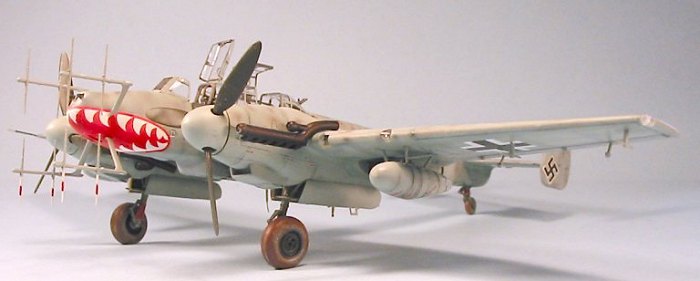
ProModeler 1/48 Bf-110G-4
|
KIT # |
5933 |
|
PRICE: |
$28.20 MSRP |
|
DECALS: |
two options |
|
REVIEWER: |
Tom Cleaver |
|
NOTES: |
Cutting Edge Cowling Conversion set and decals (48-045 Bf-110G pt 1) |

|
HISTORY |
 priorities
of propaganda, and further proof that if a lie is repeated often enough
by a sufficient number of 'experts," without it being pointed out as a
lie, it becomes "the truth." The truth about the Bf-110 series is that
there are few aircraft in the history of aircraft development that have
been more maligned more unjustly.
priorities
of propaganda, and further proof that if a lie is repeated often enough
by a sufficient number of 'experts," without it being pointed out as a
lie, it becomes "the truth." The truth about the Bf-110 series is that
there are few aircraft in the history of aircraft development that have
been more maligned more unjustly.The "kernel of truth" in the charge against the Bf-110 lies in the pre-war propaganda the airplane was subject to, and its incorrect deployment during two months of the Battle of Britain. Termed a Zerstoerer, or "Destroyer", by the Luftwaffe, the prewar image of the Bf-110 was that of a long-range bomber escort penetrating deep into enemy territory and brushing aside all opposition. Employed in this capacity during the Battle of Britain, the Bf-110 was shown to be unable to compete in terms of maneuverability against the Spitfire and the Hurricane, with the single-engine Bf-109s being called in to defend the escorts as well as the bombers. In truth, no Second World War twin-engine fighter could hold its own in a dogfight with a well-flown single-engine fighter; the most successful, the P-38, was only successful when it stuck to dive-and-zoom tactics against its opponents and stayed well away from the close-in high-g maneuvering of a dogfight.
In fact, the
primary design role of the Bf-110 had been that of bomber destroyer,
and in this role it was outstandingly su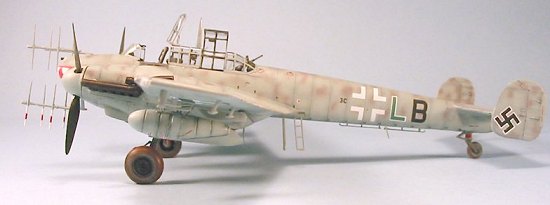 ccessful,
from its first interception of 18 RAF Wellingtons off the Heligoland
Bight on December 18, 1940, when four of the eight bombers shot down were
credited to the Bf-110s of I/ZG76, to March 31, 1944, when 200 Bf-110s
went up against 795 Lancasters and Halifaxes attacking Nuremburg and shot
down 94 of them. Two Bf-110 pilots had scores over 100 - Heinz-Wolfgang
Schnaufer (121) and Helmut Lent (102) - with a hundred others having
scores over 30.
ccessful,
from its first interception of 18 RAF Wellingtons off the Heligoland
Bight on December 18, 1940, when four of the eight bombers shot down were
credited to the Bf-110s of I/ZG76, to March 31, 1944, when 200 Bf-110s
went up against 795 Lancasters and Halifaxes attacking Nuremburg and shot
down 94 of them. Two Bf-110 pilots had scores over 100 - Heinz-Wolfgang
Schnaufer (121) and Helmut Lent (102) - with a hundred others having
scores over 30.
The first
Bf-110 variant specifically developed for night-fighting was the
Bf-110F-4, which had the 1,300 h.p. DB 601F in place of the 1,100 h.p. DB
601As of the Bf-110C; production began in 1941 and lasted through to the
end of 1942. Following the failure of the Me-210 as the intended
replacement for the Bf-110, the Bf-110 was "cleaned up" in aerodynamic
detail, and fitted with the DB 605B, which provided 1,475 h.p. The
Bf-110G-4 night fighter variant went into production in June 1942.
Flame-damping exhausts, the addition of radar antenna arrays, and the
provision of heavier armament reduced the speed of the Bf-110G by 35
m.p.h. in comparison with the 345 m.p.h. top speed of the lighter Bf-110C
day fighter. When it came to attacking the newer Lancaster and Halifax
bombers, the Bf-110G had little margin over its adversaries. At the end
of 1942, 300 of the 389 German night fighters were Bf-110s; RAF Bomber
Command lost 1,291 aircraft in night attacks, two-thirds of them credited
to the night fighters.

The original German system of night interception, known as "Himmelbett," involved one fighter in an aerial box being guided by one radar station against a single bomber. This worked successfully, provided the bombers passed through the defenses in ones and twos over a period of hours. After analyzing this system, Bomber Command changed tactics to counter Himmelbett, sending the bombers through the interception belt in a tight mass that overwhelmed the system by saturating it with possible targets. This was first used in the famous Thousand Raid against Cologne on May 30, 1942, in which the time of the attack was changed from the then-standard 7 hours to 150 minutes, with an average seven bombers passing over a given point in the route each minute, swamping the defense. Of 1,046 atackers, only 41 were lost, a 3.8% missing rate.
The
death-knell of "Himmelbett" came with the introduction of "window" by RAF
Bomber Command during the bombing raids on Hamburg in early July, 1943.
With the ground radars effectively blinded, the night fighters were left
on their own. The Germans had by this time developed airborne radar
sets, but the Lichtenstein BC radar was jammed by window as
 effectively as the
ground-based Wurzburg system.
effectively as the
ground-based Wurzburg system.
In answer to "window," Oberst von Lossberg of NJG 1 developed the tactic known as Zahme Sau, or "tame boar," in which the night fighters endeavored to get into the bomber stream and engage the bombers visually in the vicinity of the targets, depending on moonlight and firelight to allow them to see the enemy. This worked in the comparatively bright nights of summer, but the coming winter would limit such a tactic. In September, 1943, SN-2 radar was introduced, operating on a frequency that was not jammed by "window." At the same time, Major Rudolf Shoenert was able to demonstrate the effectiveness of lighter-color night fighter camouflage, which broke up the fighter's shape in moonlight rather than emphasizing its silhouette as the earlier all-black camouflage did. Shoenert was also the first to effectively use "Schrage Musik" - two 20mm MG-FF cannon mounted in the rear of the Bf-110s cockpit, firing upward at an angle of 70-80 degrees. Since none of the British bombers had a lower turret, Schrage Musik made it possible for a night fighter to formate unseen below a bomber, firing up into it. A short burst aimed into the inner wing structure would generally destroy the main spar, ripping the wing from the bomber and sending it out of control. Schnaufer, who was a gifted pilot, became so good a practitioner of this tactic that three of his kills came with his Bf-110G in close formation with bombers that were actually performing the corkscrew maneuver!
 Coupling
SN-2 and Schrage-Musik with the Zahme Sau tactic came
just in time to counter the main offensive of Bomber Command, when Air
Marshal Sir Arthur Harris initiated "The Battle of Berlin" on November
18, 1943. Harris originally sold the idea by saying that while it would
cost the RAF 500 bombers "it will cost Hitler the war." In fact, the
great night battles between November 18, 1943 and March 31, 1944, nearly
cost Harris his command, and resulted in the loss of 1,047 aircraft, 800
of them to night fighters.
Coupling
SN-2 and Schrage-Musik with the Zahme Sau tactic came
just in time to counter the main offensive of Bomber Command, when Air
Marshal Sir Arthur Harris initiated "The Battle of Berlin" on November
18, 1943. Harris originally sold the idea by saying that while it would
cost the RAF 500 bombers "it will cost Hitler the war." In fact, the
great night battles between November 18, 1943 and March 31, 1944, nearly
cost Harris his command, and resulted in the loss of 1,047 aircraft, 800
of them to night fighters.
German crews were ordered to pursue the bombers to the limit of endurance; once contact had been made they were to break off the action only when their fuel was almost gone, at which time they were to land at the nearest airfield. Losses due to fighgers running out of fuel were risked and accepted. At scramble, the crews were ready for takeoff within two minutes. As they taxied for takeoff, they received the latest position, height, course and strength of the bomber stream, and were assigned a "stacking beacon". Once at the beacon - chosen to put the fighters as near the expected route of the stream as possible - as many as fifty fighters might be circling in the darkness, yet remarkably few were lost in collisions. When ordered to leafe the beacon, the fighters were given the latest information, and were expected to then enter the stream, where they would pick out individual targets via SN-2 or home in on the bombers' H2S emissions with their Flensburg receivers. When they first contacted the bomber stream, they were to radio back the position and course of the bombers before initiating their attack.
With these tactics, the Bf-110s were able to inflict serious losses, such as the 55 bombers shot down of 648 attacking Magdeburg on January 21, 1944, or the 43 of 683 attacking Berlin on January 29. On February 19, Bomber Command lost 78 of 823 attacking Leipzig.
 The high-water
mark of the German night fighter war came on March 31, 1944, when 795
bombers headed for Nuremburg were opposed by 200 night fighers - 145 of
them Bf-110Gs - in the biggest air battle in history. The winds aloft
were stronger than forecast, and the moon was bright; the result was the
destruction of 94 attacking bombers, the greatest loss on a single
mission ever suffered by Bomber Command.
The high-water
mark of the German night fighter war came on March 31, 1944, when 795
bombers headed for Nuremburg were opposed by 200 night fighers - 145 of
them Bf-110Gs - in the biggest air battle in history. The winds aloft
were stronger than forecast, and the moon was bright; the result was the
destruction of 94 attacking bombers, the greatest loss on a single
mission ever suffered by Bomber Command.
Within a matter of weeks, the Battle of Germany came to an end, when Bomber Command was placed under the control of General Eisenhower and SHAEF, to provide support in the build-up to Operation Overlord. Bomber Command's losses went down dramatically as they changed targets to those in France and the Low Countries. The invasion of Europe quickly resulted in the destruction of the German night-fighter defenses as the radar stations in northern France, Belgium and Holland were overrun. When the bombers finally struck a strategically-significant target and stayed at it (with their commanders fighting these orders tooth and nail), the resulting destruction of the German oil industry nearly grounded the entire Luftwaffe. By the fall of 1944, Mosquitos of 100 Group were escorting the bombers in their night raids over Germany, and the German night fighters became subject to "Moskitopanik" with the hunters now relentlessly hunted whenever they took off.
The Bf-110, which had first seen operational service on the first day of the Second World War, flew its last mission five days before the end, on May 3, 1945. Reviled by its enemy's propaganda, the airplane and its crews had given their utmost in service in the defense of the homeland.
|
THE KIT |
The Pro-Modeler
Bf-110G night fighter kit first came out in 1994. The first model of a
Bf-110 night fighter in 1/48, it was the second 1/48 kit of the Bf-110,
Fujimi having released a kit of the Bf-110C/D in the late 1970s which is
still available and can be
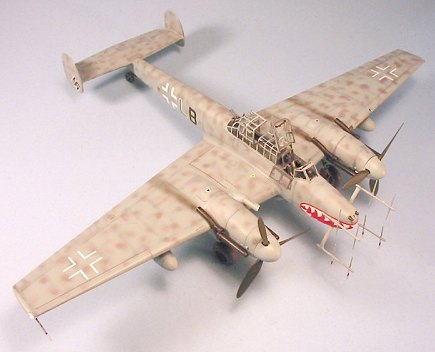 made into a good
model of the early Bf-110. In 1997, Revell-Monogram released the Bf-110G
in the G-2 day fighter/fighter-bomber version. The kit assembles easily
and makes up into a largely-accurate model of this airplane.
made into a good
model of the early Bf-110. In 1997, Revell-Monogram released the Bf-110G
in the G-2 day fighter/fighter-bomber version. The kit assembles easily
and makes up into a largely-accurate model of this airplane.
That said, the engine cowlings, spinners and propellers are not as accurate as they could be. Cutting Edge has recently brought out a conversion set that replaces the engine cowlings, spinners and propellers with resin parts that are more accurate in shape and outline. The conversion set effectively doubles the price of the kit, but results in a more accurate model. It is not that difficult to make the conversion. Additionally, Cutting Edge has produced a sheet of decals with the markings of various Bf-110G Nachtjagdwaffe "Experten," including Schnaufer, Willi Herget, Martin Drewes, Wilhelm Johnen, and Hans Jabs.
This kit as built utilizes the resin conversion set and the decals for Willi Herget's Bf-110G, which carried the "sharkmouth" from his prior service with ZG76, the "Haifisch Gruppe."
|
CONSTRUCTION |
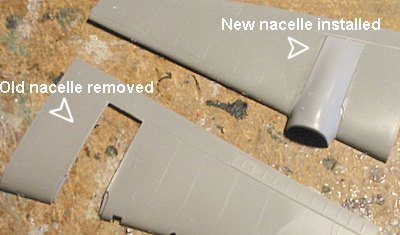 I began work on
this model with the engine conversion. The conversion set is designed to
work with the modeler cutting out the engine cowlings from the upper wing
along panel lines. The instructions are clear, and one only needs to
follow them. Once the upper wing cutout was cleaned up, the replacement
parts literally "clicked" into place with no problem.
I began work on
this model with the engine conversion. The conversion set is designed to
work with the modeler cutting out the engine cowlings from the upper wing
along panel lines. The instructions are clear, and one only needs to
follow them. Once the upper wing cutout was cleaned up, the replacement
parts literally "clicked" into place with no problem.
I then proceeded to assemble the upper and lower wing halves for right and left wings after opening up the holes in the lower wing surface for the drop tank racks. When this was done, I then attached the forward parts of the cowlings with CA glue, and also attached the oil coolers. I filled gaps as necessary with some CA glue, followed by a coat of Mr. Surfacer 500 and a light sanding session, followed by rescribing the panel lines. I finished off this part of the construction by assembling the drop tanks and their racks, and setting them aside with the wings while I turned to the fuselage.
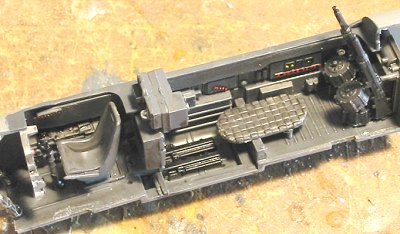 I first painted
the cockpit with Tamiya XF-24 Dark Grey, then did the necessary detail
painting of the parts. I finished that off with a wash of Tamiya "Smoke"
to pop out detail, followed by some dry-brushing with Model Master
Aluminum (non-buffing) metalizer, and topping all off with a coat of
Dullcote.
I first painted
the cockpit with Tamiya XF-24 Dark Grey, then did the necessary detail
painting of the parts. I finished that off with a wash of Tamiya "Smoke"
to pop out detail, followed by some dry-brushing with Model Master
Aluminum (non-buffing) metalizer, and topping all off with a coat of
Dullcote.
I also painted the wheel wells and all the landing gear parts and interior of the gear doors with Tamiya "RLM Grey".
Following the
kit instructions I assembled the cockpit and inserted it in the right
fuselage  half, then
closed up the fuselage. Careful assembly of the fuselage halves meant
that after I scraped down the centerline seam, I only had to apply some
Mr. Surfacer 500 to make that disappear.
half, then
closed up the fuselage. Careful assembly of the fuselage halves meant
that after I scraped down the centerline seam, I only had to apply some
Mr. Surfacer 500 to make that disappear.
I then assembled the horizontal stabilizer and the twin rudders, and attached that sub-assembly to the fuselage.
I realized that I was going to have to scratchbuild the antenna assembly under the fuselage, which I did using some .010 Evergreen rod.
With the wings attached, the model was ready for the paint shop.
|
CAMOUFLAGE & MARKINGS |
 Painting and
Camouflage:
Painting and
Camouflage:
After pre-shading the model, I painted it overall with Gunze-Sangyo "RLM76", then blotched the upper surfaces with Gunze-Sangyo "Sea Grey Medium," which is a good approximation of RLM75 (and a better shade than what Gunze markets as 'RLM75," which I think is too dark and too grey). I utilized Tamiya "Smoke" for the exhaust stains.
Assembly continues:
The only place I
ran into any trouble with this project was attaching the flame damper
exhausts. For some reason, the resin cowling wasn't designed quite
right, and I had the devil's own time getting the left inner flame d amper
to fit in any way that looked right. Fortunately, the model isn't built
for a contest, and from 12 inches away the final result looks right,
though at close range one can easily see that there was a bit of "hacking
and fiddling" to get that attached.
amper
to fit in any way that looked right. Fortunately, the model isn't built
for a contest, and from 12 inches away the final result looks right,
though at close range one can easily see that there was a bit of "hacking
and fiddling" to get that attached.
I assembled and attached the landing gear and gear doors, then attached the drop tanks. I then attached the resin prop blades, which are more accurate in shape than the kit props, which have too much "paddle effect."
Decals:
I used the Cutting Edge "Bf-110 Special No. 1" sheet to do Willi Herget's Bf-110G-4 of NJG 4 in the Spring of 1944, at the height of the night fighter war over Germany. Herget had previously served with ZG 76 "Haifisch Gruppe," and painted his later 110s with the sharkmouth, which adds a nice bit of color to the model. These decals were a bit thick, and I ended up hitting them with Micro-Sol and then following that up with some Gunze-Sangyo "Mr. Mark Softer" to get them to finally sit down.
Following the setting of the decals, I gave the model a final coat of Future, then two coats of Dullcote.
|
FINAL CONSTRUCTION |
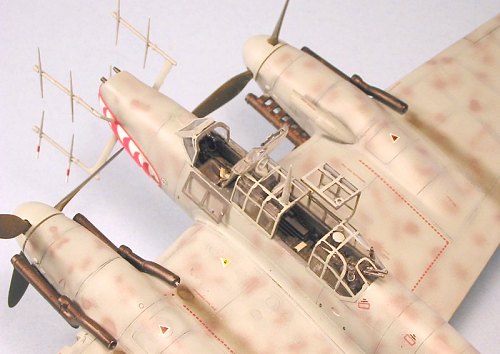 I had Futured
the open cockpit canopy, and attached the canopy at this point in the
open position, after unmasking the clear areas which I had covered with
Scotch brand transparent tape.
I had Futured
the open cockpit canopy, and attached the canopy at this point in the
open position, after unmasking the clear areas which I had covered with
Scotch brand transparent tape.
Finally, I attached the "stags horns" of the SN-2 radar. These joints are very fragile, and I strongly recommend that you refrain from touching the nose once you have them glued into position and set up.
|
CONCLUSIONS |
The Pro-Modeler Bf-110G-4 makes up into a very nice looking model of this important German fighter and deserves to be in any collection of Luftwaffe aircraft models.
I am including
a photo of another P-M Bf-110G-4 built out of the box, so that you
can see the differences in the props, spinners and cowling shapes between
the OOB model and the modified one. The differences are subtle but
noticeable. I personally wasn't aware of them until Cutting Edge pointed
it out, but now that I look at the corrected model and photos of
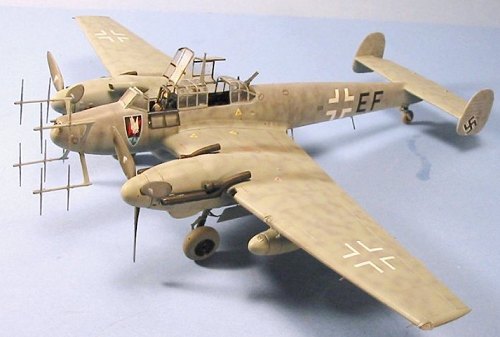 actual Bf-110Gs I
can see that the original shapes are really wrong. Are they "wrong
enough" for you to spend an extra $20 to make them right? That depends
on the kind of modeler you are and the kind of model you want to end up
with. "Getting it right" in this case is not that hard to do (even with
the flame damper attachment problem), and in fact this could be a good
first kit for a modeler to try doing a model with a resin correction set,
since the set is as easy to use as this one is.
actual Bf-110Gs I
can see that the original shapes are really wrong. Are they "wrong
enough" for you to spend an extra $20 to make them right? That depends
on the kind of modeler you are and the kind of model you want to end up
with. "Getting it right" in this case is not that hard to do (even with
the flame damper attachment problem), and in fact this could be a good
first kit for a modeler to try doing a model with a resin correction set,
since the set is as easy to use as this one is.
Review kit courtesy of the Modeling Madness Editor
Resin correction set courtesy of Meteor Productions.
November 2003
If you would like your product reviewed fairly and fairly quickly, please contact the editor or see other details in the Note to Contributors.